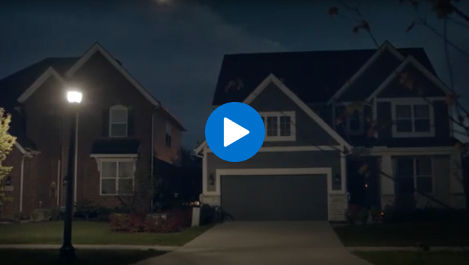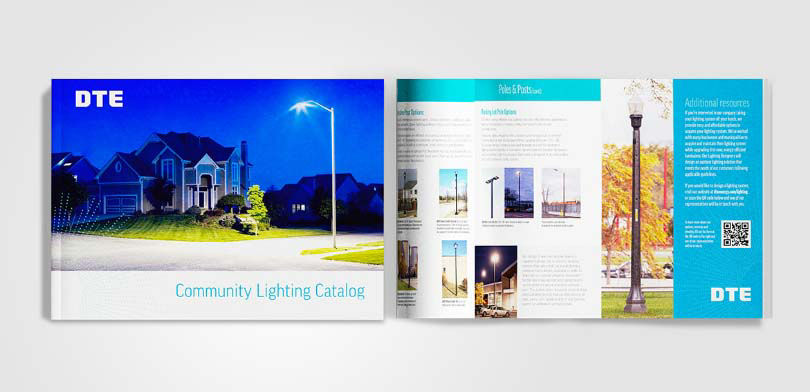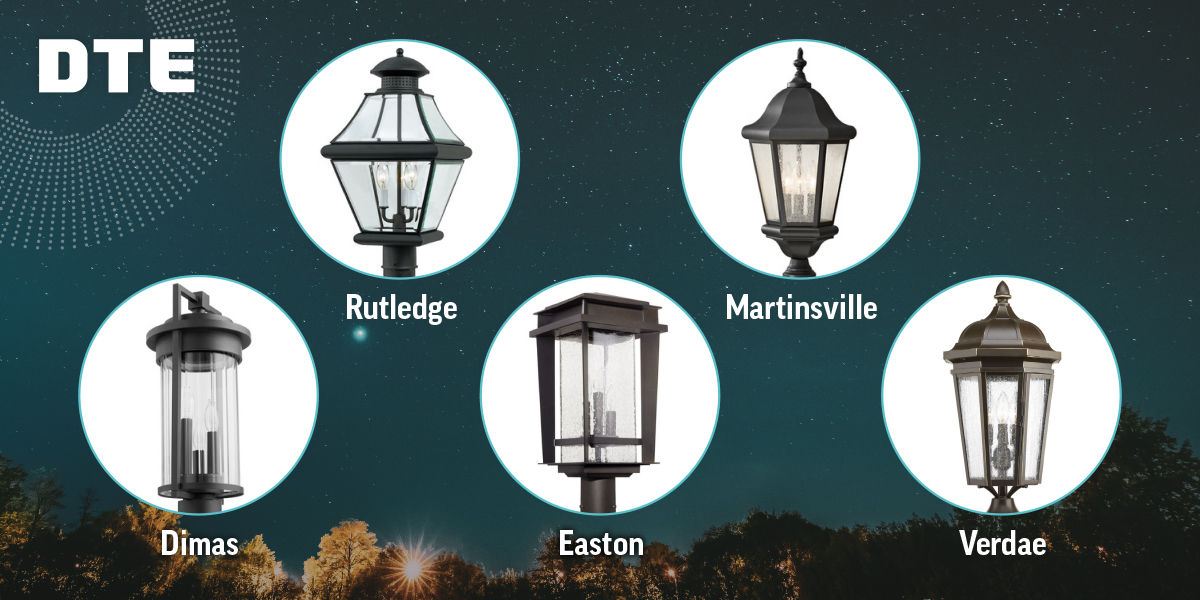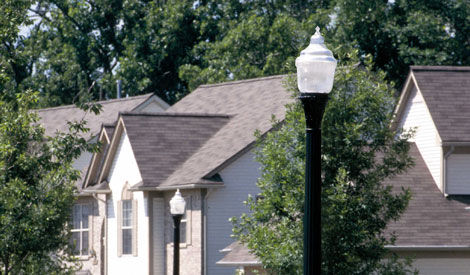Outdoor Residential Lighting to Protect Your Home
Our Outdoor Protective Lighting service offers maintenance-free exterior lighting for your home. Protecting your property and neighborhood with efficient and affordable outdoor lighting is easy with DTE.
Get inspired by our video and catalog, review the benefits and request your free estimate.
Illuminate & Brighten Vibrant Communities
Worry-free Service
Interruptions to outdoor lighting can happen for many different reasons including power outages, mechanical issues or scheduled equipment maintenance. DTE provides maintenance 24 hours per day, seven days per week, 365 days per year to ensure your property is safely lit!
Enhance Property Value
Well-designed lighting can transform your home’s exterior appearance, making it a neighborhood showpiece. Lighting adds ambiance and character and can create a more welcoming environment. Lighting also increases curb appeal and can make your home look great in photographs – all of which increase your property value in the real estate market.
Report an Outdoor Lighting Issue
Tips and Help
Explore our Lighting Solutions
Color Rendering
The effect a light source has on the color appearance of an object when compared to its color appearance under a reference light source. The Color Rendering Index (CRI) scale ranges from 0 to 100 - higher values indicating better color rendering with less color shift to object.
Correlated Color Temperature (CCT)
The color appearance of light produced by a light source measured by the Kelvin Scale (K). Color temperatures of light sources may range in appearance between warm white (1,800K – 3,000K), cool white (3100K - 4500K) and daylight (4,600K - 6,500K).
Efficacy
Total luminous flux emitted divided by the total power input of a luminaire. It is expressed in lumens per watt (L/W).
Efficiency
The total amount of light emitted by a luminaire divided by the total amount of light emitted by a light source (lamp, light emitting diode, etc.). Less light is absorbed, internally, by higher efficiency luminaires.
Footcandle (fc)
A unit of measure for luminance equal to a uniformly distributed flux of one lumen incident upon one square foot of surface area.
HID
A high intensity discharge (HID) light source produces an electric arc to generate light in a stabilized arc tube. HID lighting sources include mercury vapor, metal halide, and high pressure sodium.
Lamp
A device that produces light by means of an electric arc generated through electrodes housed inside a translucent or transparent arc tube. High-intensity discharge lamps, incandescent lamps and fluorescent lamps are typically used for outdoor lighting.
Lamp Lumen Depreciation
A factor used in lighting calculations to account for the light loss that takes place in a lamp due to the gradual decay in lumen output over a specified period of burning time.
Lens
A component of a luminaire used to redirect light to control the light distribution. Lenses are composed of glass, acrylic, or polycarbonate materials.
Lens Emitting Diode (LED)
A light source that becomes illuminated by the movement of electrons through a semiconductor material.
Light Loss Factor (LLF)
A product of several depreciation factors used in lighting design to predict a luminaires performance over a predetermined number of operating hours. These factors include lamp lumen depreciation (LLD), luminaire dirt depreciation (LDD), atmospheric conditions, voltage regulation, maintenance procedures, etc.
Light Trespass
An encroachment of unwanted light, across property boundary lines, that may cause a nuisance or loss of privacy to neighboring properties.
Color Rendering
The effect a light source has on the color appearance of an object when compared to its color appearance under a reference light source. The Color Rendering Index (CRI) scale ranges from 0 to 100 - higher values indicating better color rendering with less color shift to object.
Lighting Distribution
A luminaire classification system describing the lateral and vertical light projected or dispersed from a luminaire. Typical roadway and area light luminaire classifications range from Type 1 to Type 5 lighting distributions.
Lumen
The unit of measurement for light output or luminous flux.
Luminaire (outdoor lighting fixture)
A luminaire is a complete electric light unit consisting of varying components assembled as a system to generate light, direct and/or diffuse light, house and protect the lighting components, and connect the lighting components to a power supply.
Luminaire Dirt Depreciation (LDD)
A factor used in lighting calculations to account for the light loss due to the accumulation of dirt on the luminaire. The LDD is contingent upon environment, cleaning schedules and the type of luminaire used.
Mounting Hight
The vertical distance between the luminaire and the surface to be lighted. It includes both the pole length and the base above grade to which the pole is mounted.
Optical System
A component of a luminaire used to control light output or distribution. A luminaire may consist of a lens, mirror, glass or plastic globe, or a combination of these components to control light.
Lighting Ordinances (Municipal)
Rules, regulations and codes enacted into law by local governing bodies that define outdoor lighting standards and submittal requirements. Ordinance rules are typically restricted by zoning classifications; residential, commercial and industrial.
Reflector
A specular or diffuse surface used to reflect or redirect light produced from a light source.
Refractor
A prismatic lens used to refract or change light direction produced from a light source.
Uniformity
A measure of how consistent or uniform lighting is distributed over a task area. Uniformity ratios are used in lighting design to improve the range of human vision. For example, observing an area with bright spots beneath outdoor lighting fixtures surrounded by dark spots is an indication of poor lighting uniformity.
Watt
a unit of power, equivalent to one joule per second, corresponding to the rate of consumption of energy in an electric circuit.
Product Sheets
Each product sheet contains detailed information, including location application, installation requirements, performance specs and color distribution. Learn more about our lighting portfolio in the product sheets below or design a light using our interactive tool.
Acorn Series
Colonial Series
LED Flood Series
LED Roadway Series
NEMA Head Series
LED Area Light Series
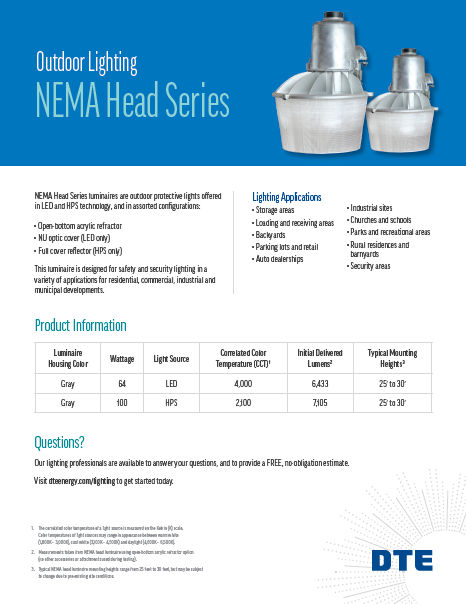
Solution Sheets and Case Studies
Whether you need a single light or hundreds of lights, we’ll deliver a custom solution tailored to your unique needs. If you’re a homeowner who needs additional light around your house or condo, or a member of a homeowners’ association looking to enhance safety and ambiance — and improve property values, we’ve got you covered.
Outdoor Lighting Solutions
Security Lighting Solutions
Security Lighting Solutions (Spanish)
Residential Neighborhood Case Study: Indian Village
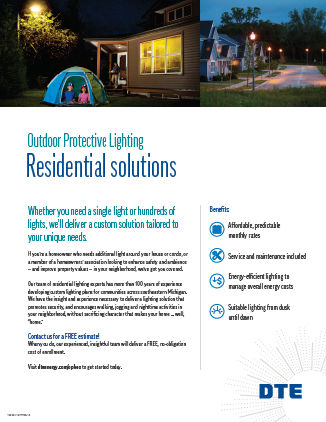
Frequently Asked Questions
We have two residential lighting options for utility poles, our LED Roadway Series (58 W) and our 64W NEMA Head Series. Depending on the style of light you choose, the cost will be $15-$16 per month, which covers electricity and maintenance. It will be added to your monthly DTE electric bill for convenience. For residential applications, there is typically zero out of pocket costs for installation. However, any additional costs, such as additional electrical equipment required for the light to be installed, would be determined on a case-by-case basis.
Yes, you must sign a five-year contract to install this type of lighting. If you sell your property within the initial five-year term, you are allowed to transfer the contract to the new owner or resident with their agreement. If the light is unable to be transferred and needs to be removed within the initial five years, there is an early termination fee.
If you live within a city with neighbors nearby, it’s likely light could spill onto their property and sometimes this can generate a complaint from that neighbor. We will work with you to set up the light with the best installation to limit light trespassing or spillover. Please note that not all situations will work for utility-grade lighting.
Some cities have specific lighting ordinances that must be complied with. As we move forward with your specific request, we will work with you and your city to determine what the rules are and how to comply.
Once the signed contract has been received by DTE, the average installation time is 5 weeks.
If you have an existing DTE outdoor protective light on a DTE wood utility pole, there are new LED options in various styles that it can be upgraded to. There is no cost to upgrade to a new LED. DTE does not offer any replacement services for privately owned lighting.
Unfortunately, DTE does not offer services for security cameras at this time.
All DTE outdoor protective lighting is controlled automatically by photocells and cannot be independently controlled. This is a dusk to dawn lighting solution.
DTE can work with you to add new wood poles to locations lighting is needed on your property, as long as there is enough clearance and can be powered by overhead DTE distribution that is near the new pole location. There are out of pocket costs for adding new wood poles, which would start at approximately $800 and could increase from there depending on scope of work.
Outages can be reported in our Outage Center via the Outdoor Lighting Problem form.
*Additional terms and conditions apply. DTE Outdoor Protective Lighting is governed by the applicable provisions of the Company’s Rate Book for Electrical Service (the “Rate Book”) established by the Michigan Public Service Commission (“MPSC”), including but not limited to Rate Schedule No. D9. The Rate Book is subject to change from time to time by order issued by the MPSC. Taxes and surcharges not included.
If you’re looking for lamp post lighting for your front lawn, we offer five different decorative lamp post styles separate from this program. Please call (833) 383-7678 or fill out this separate request form to inquire about purchasing a decorative lamp post option.
